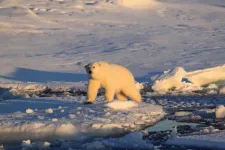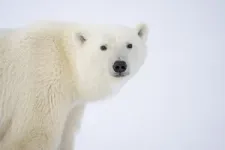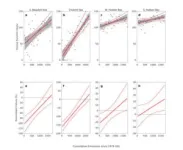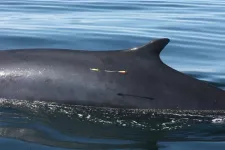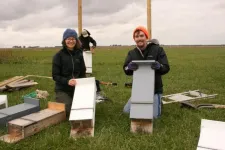(Press-News.org) New research from the University of Washington and Polar Bears International in Bozeman, Montana, quantifies the relationship between greenhouse gas emissions and the survival of polar bear populations. The paper, published online Aug. 31 in Science, combines past research and new analysis to provide a quantitative link between greenhouse gas emissions and polar bear survival rates.
A warming Arctic is limiting polar bears’ access to sea ice, which the bears use as a hunting platform. In ice-free summer months the bears must fast. While in a worst-case scenario the adult bears will die, before then they will lose the ability to successfully raise cubs.
“Until now, scientists hadn’t offered the quantitative evidence to relate greenhouse gas emissions to population decline,” said second author Cecilia Bitz, a UW professor of atmospheric sciences.
Bitz did data analysis for the new report that shows a direct link between cumulative greenhouse gas emissions and polar bear demographic changes. The link largely explains recent declining trends in some polar bear subpopulations, such as in western Hudson Bay. The paper also has policy implications because it allows a formal assessment of how future proposed actions would impact polar bears.
“I hope the U.S. government fulfills its legal obligation to protect polar bears by limiting greenhouse gas emissions from human activity,” Bitz said. “I hope investments are made into fossil fuel alternatives that exist today, and to discover new technologies that avoid greenhouse gas emissions.”
In 2008, polar bears became the first species listed under the Endangered Species Act because of the threat of climate change. The biological link between warming and polar bear survival was clear, and scientists projected that up to two-thirds of the world’s polar bears could disappear by mid-century.
The Endangered Species Act requires that any government-authorized projects, including oil and gas leases, do not further endanger any listed species. But a document released by the U.S. Department of the Interior in 2008, known as the Bernhardt Opinion, required specific proof of how a proposed project’s greenhouse gas emissions would affect a species’ survival before the ESA could be fully implemented for species threatened by climate change.
“We’ve known for decades that continued warming and sea ice loss ultimately can only result in reduced distribution and abundance of polar bears,” said lead author Steven Amstrup, chief scientist emeritus at Polar Bears International and adjunct professor at the University of Wyoming. “Until now, we’ve lacked the ability to distinguish impacts of greenhouse gases emitted by particular activities from the impacts of historic cumulative emissions. In this paper, we reveal a direct link between anthropogenic greenhouse gas emissions and cub survival rates.”
The new paper, published in the 50th anniversary year of the Endangered Species Act and the 15-year anniversary of the listing of polar bears, brings new science to fill that knowledge gap.
Advances in climate science mean that precise links can now be established between emissions and species survival. Bitz was second author on a 2020 Nature Climate Change study that modeled polar bear survival against sea ice decline, connecting polar bear fasting to ice-free days and calculating the annual fasting limits that lead to mortality. That study considered not just adult polar bear’s survival, but also its recruitment success, meaning its ability to have cubs and raise them to the age of independence.
The new paper links ice-free days and polar bear fasting limits to cumulative greenhouse gas emissions. It finds that, for example, the hundreds of power plants in the U.S. will emit more than 60 gigatons of greenhouse gas emissions over their 30-year lifespans, which would reduce polar bear cub survival in the southern Beaufort Sea population by about 4%.
“Overcoming the challenge of the Bernhardt Opinion is absolutely in the realm of climate research,” Bitz said. “When the memo was written in 2008, we could not say how human-generated greenhouse gas emissions equated to a decline in polar bear populations. But within a few years we could directly relate the quantity of emissions to climate warming and later to Arctic sea ice loss as well. Our study shows that not only sea ice, but polar bear survival, can be directly related to our greenhouse gas emissions.”
The study has implications beyond polar bears and sea ice, authors say. The same method of analysis can be adapted for other species and species habitat with direct connections to global warming, such as coral reefs, the endangered Key deer that reside in the Florida keys, or beach-nesting species that are affected by rising sea levels.
“Polar bears are beautiful creatures, and I hope they survive global warming. However, the health and well-being of humans, especially the most vulnerable, is of the utmost importance,” Bitz said. “All of us have experienced heat extremes in the last few years. The harm is inescapable.
"Everything governments and industries can do to reduce greenhouse gas emissions matters, and will help avoid the worst consequences. I’m excited to see the innovative proposals for the Inflation Reduction Act — I hope they stimulate the healthier future that polar bears, and all of us, need.”
The study was funded by Polar Bears International and the National Science Foundation.
###
END
Study connects greenhouse gas emissions to polar bear population declines, enabling greater protections under Endangered Species Act
2023-08-31
ELSE PRESS RELEASES FROM THIS DATE:
Exciting the brain could be key to boosting maths learning, says new study
2023-08-31
Exciting a brain region using electrical noise stimulation can help improve mathematical learning in those who struggle with the subject, according to a new study from the Universities of Surrey and Oxford, Loughborough University, and Radboud University in The Netherlands.
During this unique study, researchers investigated the impact of neurostimulation on learning. Despite the growing interest in this non-invasive technique, little is known about the neurophysiological changes induced and the effect it has on learning.
Researchers found that electrical noise ...
How does “MAD” accretion form around a black hole?
2023-08-31
An international scientific team has revealed for the first time the magnetic field transport processes in the accretion flow of a black hole and the formation of a "MAD"—a magnetically arrested disk—in the vicinity of a black hole.
The researchers made the discovery while conducting multi-wavelength observational studies of an outburst event of the black hole X-ray binary MAXI J1820+070, using Insight-HXMT, China's first X-ray astronomical satellite, as well as multiple telescopes.
Key to their discovery was the observation that the radio emission from the black hole jet and the optical emission from the outer ...
Mutation rates in whales are much higher than previously reported
2023-08-31
An international team of marine scientists, led by the University of Groningen in the Netherlands and the Center for Coastal Studies in the USA, has studied the DNA of family groups from four different whale species to estimate their mutation rates. The results revealed much higher mutation rates than previously thought, and which are similar to those of smaller mammals such as humans, apes, and dolphins. Using the newly determined rates, the group found that the number of humpback whales in the North Atlantic before whaling was 86 percent lower than earlier studies suggested. The study is the first proof that this method can be used to estimate mutation rates ...
Peering into nanofluidic mysteries one photon at a time
2023-08-31
Researchers at University of Manchester and the École polytechnique fédérale de Lausanne (EPFL), Switzerland, have revealed an innovative approach to track individual molecule dynamics within nanofluidic structures, illuminating their response to molecules in ways never before possible.
Nanofluidics, the study of fluids confined within ultra-small spaces, offers insights into the behaviour of liquids on a nanometer scale. However, exploring the movement of individual molecules in such confined environments has been challenging due to the limitations of conventional microscopy techniques. This obstacle prevented ...
Study demonstrates adding complex component of milk to infant formula confers long-term cognitive benefits
2023-08-31
LAWRENCE, KANSAS — Breast milk is widely acknowledged as the most beneficial nutrition for infants, but many families face medical or logistical challenges in breastfeeding. In the U.S., just 45% of infants continue to be exclusively breastfed at 3 months of age, according to the Centers for Disease Control.
For decades, researchers have sought to create a viable complement or alternative to breast milk to give children their best start for healthy development. New research out of the University of Kansas has shown how a complex component of milk that can be added to infant ...
Do artificial roosts help bats? Illinois experts say more research needed
2023-08-31
URBANA, Ill. — Artificial roosts for bats come in many forms — bat boxes, condos, bark mimics, clay roosts, and cinder block structures, to name a few — but a new conservation practice and policy article from researchers at the University of Illinois Urbana-Champaign suggests the structures haven’t been studied rigorously enough and may harm bats in some scenarios. The article, published in Conservation Biology, lays out potential dangers and encourages more research on the popular conservation practice.
“The major emphasis among conservation managers using artificial roosts is how to attract ...
JMIR Dermatology call for papers theme issue on AI and ChatGPT in dermatology
2023-08-31
JMIR Dermatology Editor-in-Chief: Robert Dellavalle, MD, PhD, MSPH and guest editors James A Solomon, MD, PhD, FAAD and Ian Brooks, PhD welcome submissions to a special theme issue examining "Artificial Intelligence (AI) and ChatGPT in Dermatology."
JMIR Dermatology welcomes all topics related to diseases of the skin, hair, and nails, with a wide breadth and depth of papers focusing on AI applications. All topics at the intersection of dermatology, AI, and ChatGPT are eligible for this theme issue.
The journal ...
An ‘introspective’ AI finds diversity improves performance
2023-08-31
An artificial intelligence with the ability to look inward and fine tune its own neural network performs better when it chooses diversity over lack of diversity, a new study finds. The resulting diverse neural networks were particularly effective at solving complex tasks.
“We created a test system with a non-human intelligence, an artificial intelligence (AI), to see if the AI would choose diversity over the lack of diversity and if its choice would improve the performance of the AI,” says William Ditto, professor of physics at North Carolina State University, director ...
Penn State professor to lead field campaign to study climate in Baltimore area
2023-08-31
UNIVERSITY PARK, Pa. — Kenneth Davis, professor of atmospheric and climate science at Penn State, will lead a team of 23 investigators from 13 research institutions in a new field campaign supported by the U.S. Department of Energy (DOE) to study surface-atmosphere interactions around Baltimore, Maryland, to see how they influence the city’s climate. The new campaign, called the Coast-Urban-Rural Atmospheric Gradient Experiment (CoURAGE), is expected to start in October 2024 and run through September 2025.
CoURAGE will contribute to the Baltimore Social-Environmental ...
Covid pandemic may have changed the gut bacteria of infants, research finds
2023-08-31
Infants who spent most of their first year in the pandemic have fewer types of bacteria in their gut than infants born earlier, according to a team of developmental psychology researchers.
The findings, published in Scientific Reports, showed that infants whose gut microbes were sampled during the pandemic had lower alpha diversity of the gut microbiome, meaning that there were fewer species of bacteria in the gut. The infants had a lower abundance of Pasteurellaceae and Haemophilus—bacteria that live within humans and can cause various infections—and significantly different beta diversity, which tells us how similar or dissimilar the gut microbiome for ...
